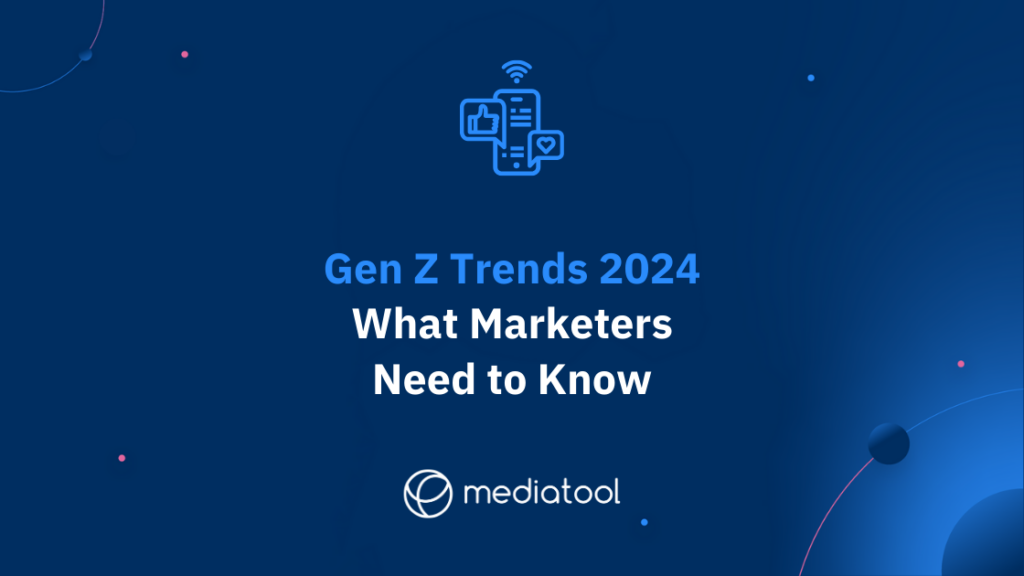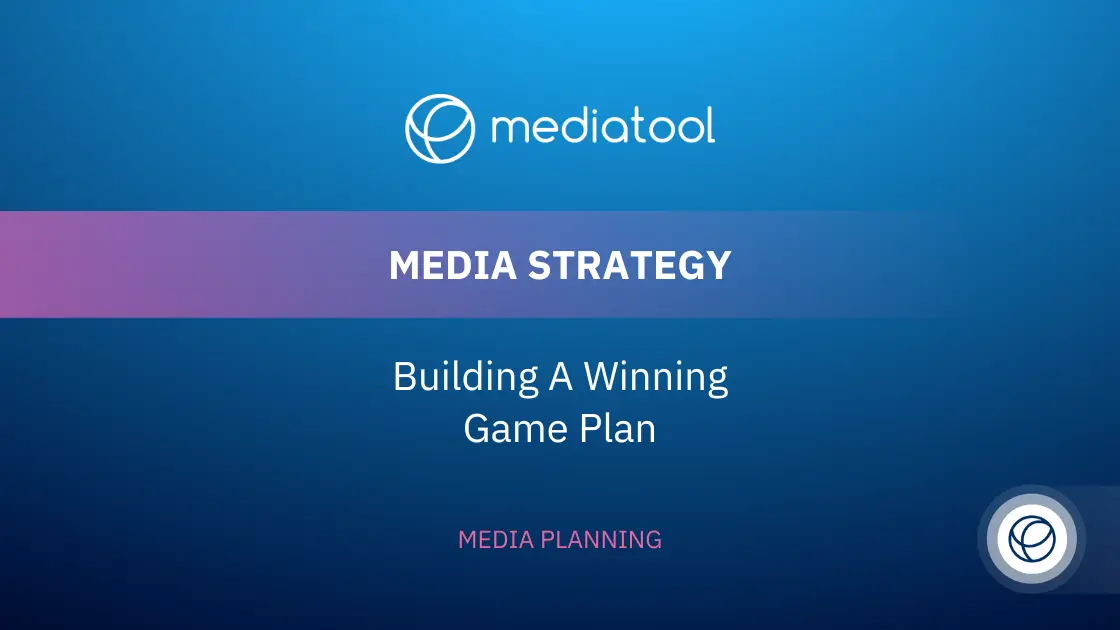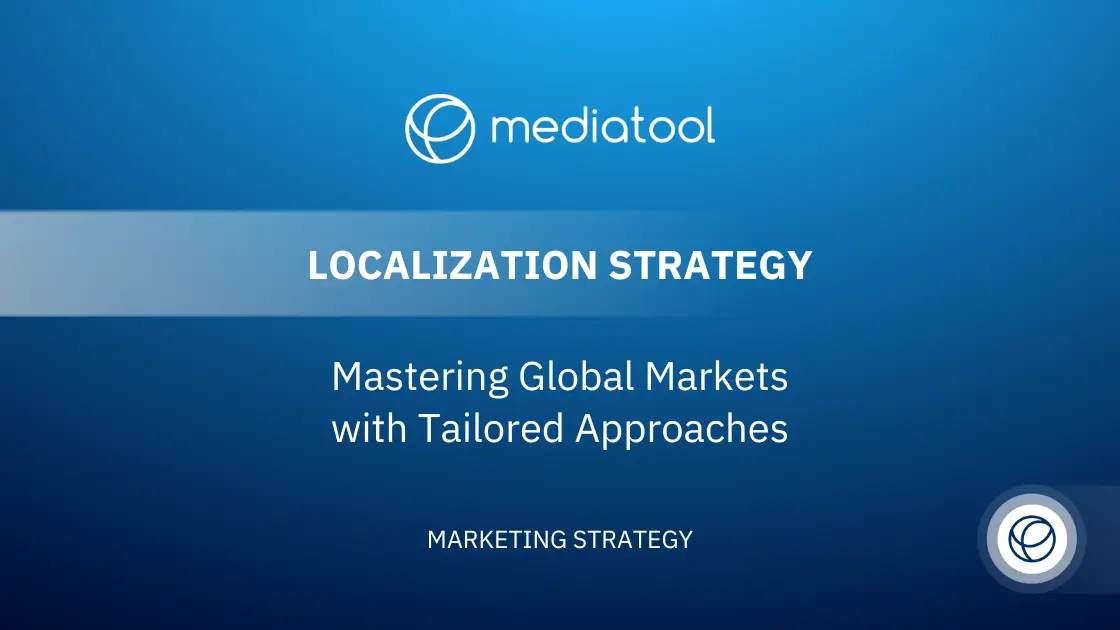Gen Z – the generation that’s sent marketers into a frenzy with their unique behaviors and media consumption habits. This woke and aware cohort has a collective $450 billion in spending power collectively, so it’s no wonder why brands are scrambling to figure out the best Gen Z trends to reach them.
As the most connected generation yet, Gen Z is often called “digital natives” due to their familiarity with technology from a young age. While it’s easy to think of Gen Z as one homogenous group, in reality, they’re a diverse crowd–and understanding what drives them is key for marketers trying to target this age group.
Knowing their media consumption habits can help you craft campaigns that give this demographic what they want.
In this article, we’ll break down who Gen Z is, what brands are doing to target them, and outline some of the more popular Gen Z trends.
Gen Z Trends: How Do Gen Zers Think?
Welcome to the fascinating world of Generation Z! You’ve likely heard a buzz about them – and for good reason. They’re not just the latest generation to enter the workforce and marketplace; they’re revolutionizing our approach to technology, social issues, and so much more. Born between the late 1990s and early 2010s, Gen Zers are the epitome of digital natives. From their early years, they’ve been immersed in a world of the internet, social media, and ever-evolving mobile devices, crafting a distinct set of habits and viewpoints.
So, what really makes Gen Z tick? At their core, they value authenticity, diversity, and technological innovation. They’re not just following in the footsteps of the previous generation of millennials or even baby boomers; they’re carving out their own path and redefining societal norms. They’re a generation that expects change and embraces it wholeheartedly. A national survey by BBMG and GlobeScan revealed that, by a 5-to-1 margin, Gen Z does not trust businesses to act in the best interests of society, and nearly one in four can’t recall a single brand they consider to be purposeful.
But it’s not just their tech-savviness that sets them apart. Gen Zers are acutely aware of social justice issues, from climate change to mental health concerns. They’re more ethnically diverse than previous generations, adding rich layers of perspective to everything they touch. This depth of understanding and empathy shapes their buying decisions, social interactions, and career paths.
Gen Z’s influence in 2024 is vast, extending from the way they consume media to their unique approach to problem-solving and innovation. They’re not just consumers; they’re creators, thinkers, and pioneers in their own right. They’re redefining what it means to engage with brands, demanding that companies not only talk the talk but also walk the walk when it comes to social issues.
As we get into the defining trends of Gen Z in 2024, we’ll uncover how their preferences are shaping industries and sparking new waves of innovation. Their impact on the market is substantial, from their preferences for mobile-first content to their reliance on social media platforms as primary sources of information. Gen Z’s purchasing power is a force to be reckoned with, and their preferences are leading the charge for a new era of consumerism.
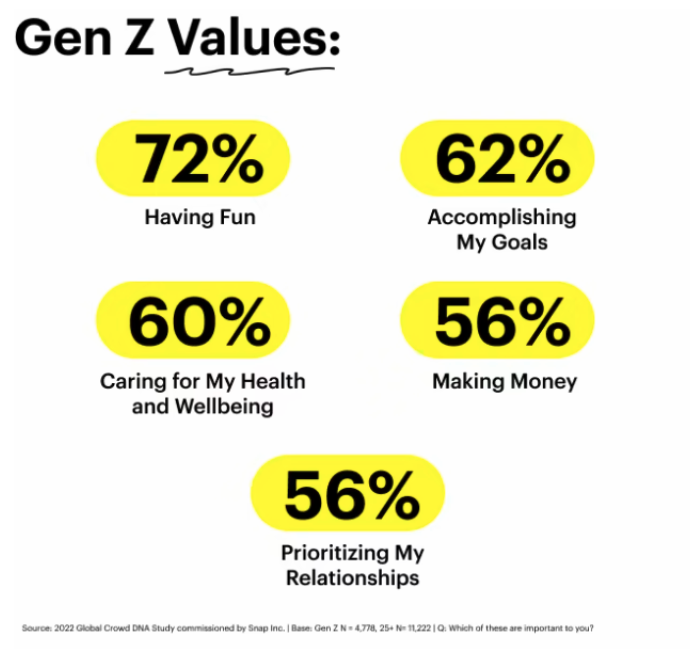
Snapchat also found that Gen Z has five core values:
- Making money
- Having fun
- Accomplishing their goals
- Caring for their health and well-being
- Prioritizing their relationships
These values show that Gen Z wants a healthy work-life balance to ensure they have time for friends and family.
So, let’s get ready to explore these trends in depth. With Gen Z, expect the unexpected – their approach is as dynamic as it is influential.
Stay tuned as we cover the world of Gen Z, a generation that’s not just changing the game but rewriting the rules.
5 Gen Z Trends To Incorporate In 2024
Gen Z’s unique media consumption habits have created several trends essential for marketers to include in their strategies. Here’s a look at some of the biggest Gen Z trends to watch out for in 2024:
1. Mobile-First Content
75% of Gen Zers choose mobile devices as their go-to tech. It’s no wonder they’re often seen glued to their screens. For them, mobile devices offer everything from the latest shopping experiences to social networking, gaming, and staying updated with global events. Consider brands like Nike, which are nailing it with their mobile-first content on social media platforms like Instagram. They’ve cracked the code on delivering immersive experiences that captivate this tech-forward crowd.
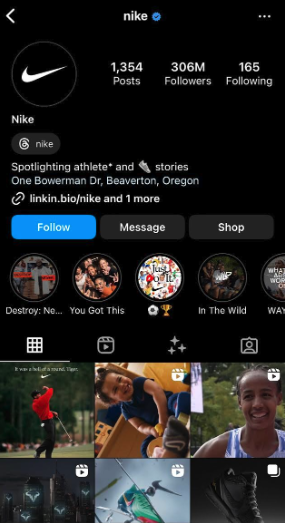
Nike Instagram
Nike exemplifies success in captivating Gen Z consumers with its inclusive, mobile-first strategy. By leveraging Instagram, Nike allows customers to seamlessly shop through the platform, using the ‘View Shop’ feature to directly navigate to product pages. This approach underlines the importance of mobile-optimized shopping experiences for Gen Z.
Strategic Takeaways
Here’s how to tap into the Gen Z market: make your digital content irresistibly mobile-friendly. We’re talking sleek apps, engaging social media integrations, and websites that are not just visually stunning on mobile devices but also packed with interactive experiences. It’s not merely about aesthetic appeal; it’s about creating an experience that mirrors the dynamic and multifaceted lifestyle of Gen Z.
Gen Z’s media consumption habits, particularly on social platforms, are defining trends in digital marketing. They’re the digital natives who grew up in a world where the lines between online and offline blur, making them a generation of consumers with significant purchasing power and influence. From their mental health concerns to their social awareness, Gen Z’s values permeate their consumer behavior.
For Gen Zers, mobile devices are tools for more than just consumption; they’re platforms for self-expression, learning (thanks to educational content on apps like TikTok), and driving social change. They’re also the generation most likely to make impulse purchases based on what they see in their digital world.
So, if you’re looking to engage with the most ethically diverse, socially conscious, and digitally savvy generation yet, your content needs to be where they are – on mobile.
2. Social Shopping
The influencer culture deeply influences Gen Z’s shopping habits, with nearly three-quarters of this demographic following influencers on social media platforms. A significant majority of Gen Z consumers often discover new products through these platforms, placing influencers ahead of traditional celebrities in terms of impact and trust. YouTube influencers like PewDiePie and MrBeast, for example, wield considerable influence over Gen Z’s buying decisions, often more so than conventional celebrities.
Influencers’ knowledge about the products they endorse and their relatability significantly sway Gen Z shoppers, with 50% of this age group citing influencer recommendations as a critical factor in their purchasing choices. This generation values the authenticity and sincerity of influencers, often viewing them as peers rather than distant figures.

The jewelry brand Mejuri uses micro-influencers to promote its products. Kate Case, for instance, currently has 3k followers, which is a little by traditional influencer standards. But because she seems like an everyday person, her content would feel authentic to a younger audience.
Takeaway:
The way Gen Z shops is a reflection of their core values and media consumption habits. They prefer buying from brands that not only understand their digital-native lifestyle but also align with their social awareness and ethical standards. This is a generation that cares deeply about issues like mental health, social justice, and climate change, and this reflects in their purchasing decisions.
For brands aiming to engage with Gen Z consumers, the strategy extends beyond conventional advertising. It involves diving into the social media universe, understanding what Gen Zers care about, and aligning with those values through authentic collaborations. This approach goes a long way in establishing a loyal customer base among Gen Z shoppers, who are known for their impulse purchases and high affinity for brands that get their language and values.
In a nutshell, social shopping is not just a trend among Gen Z; it’s a fundamental aspect of their consumer behavior. It’s about tapping into the platforms where they spend most of their time and engaging them in a way that’s both meaningful and genuine. Brands that succeed in doing this will not only win over Gen Z shoppers but will also set new standards in digital marketing and e-commerce.
3. Driven By Values
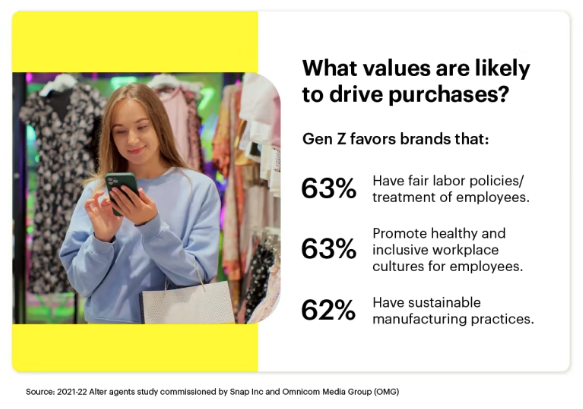
This is a biggie: An impressive half of Gen Zers expect brands to actively take a stand on social issues. It’s crucial to note that Gen Z isn’t just any generation; they’re the most diverse group yet, and they’re deeply invested in issues like climate change, racial justice, and LGBTQ+ rights.
The Snapchat generation is 3X more likely to say businesses should “serve communities and society” rather than simply “make good products and services.” Brands are also more likely to be called out by Gen Z than all others to make a difference by “using their voice to advocate or speak out” on the most pressing issues of our times.
Brands like Fenty Beauty are trailblazers in this regard, having set new inclusivity standards in the beauty industry. Gen Z is looking for brands that don’t just talk the talk but also walk the walk.
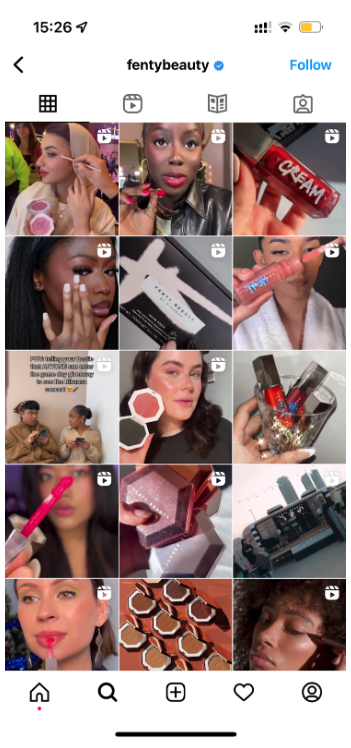
Back in 2017, Fenty Beauty launched with 40 foundation shades, consistent with their focus on inclusive beauty. They’ve since become the standard in cosmetic equality and representation. A quick look at Fenty’s Instagram feed shows an array of skin colors and culturally-diverse models. That’s how it’s done.
So, what’s the game plan for brands? It’s essential to align your brand values with those of Gen Z. This generation is looking for more than catchy slogans; they want to see tangible actions and sincere commitments. For Gen Z, authenticity and concrete action are more than just buzzwords – they’re non-negotiables.
Takeaway:
The values Gen Z holds dear significantly influence their buying decisions and brand loyalty. This generation, characterized as digital natives and social media savvy, is not only concerned with a brand’s product quality but also with its ethical stance and social impact. Their media consumption habits on platforms like TikTok and other social platforms offer a window into their world, one where social justice, mental health, and environmental concerns take center stage.
For Gen Z, every purchase is a statement of their values. They are more likely to spend their money on brands that mirror their beliefs and contribute positively to social causes. This is a generation that cares, and they expect the same from the companies they support. They are the first generation to grow up with such easy access to information, making them more informed and socially aware than their older counterparts.
Brands looking to appeal to Gen Z need to understand that this generation’s purchasing power is tied to their values. They’re not just consumers; they’re advocates and influencers in their own right. They care deeply about issues like climate change, social justice, and mental health, and they want to support businesses that are actively working to make a difference in these areas.
4. Social Media Platforms As Search Engines
Looking for recipes? Use TikTok. Outfit ideas? Instagram it.
Move over, Google; Gen Z has a new way to search. For this most likely generation to embrace digital trends, platforms like TikTok and Instagram are the new search engines. Gen Z prefers visual learning over traditional text-based learning. About 40% of Gen Zers are turning to these social media giants for everything from the latest in pop culture to practical how-to guides. Adobe Express, for instance, is acing this trend by offering engaging tutorials on TikTok, tailored specifically for the younger generation.
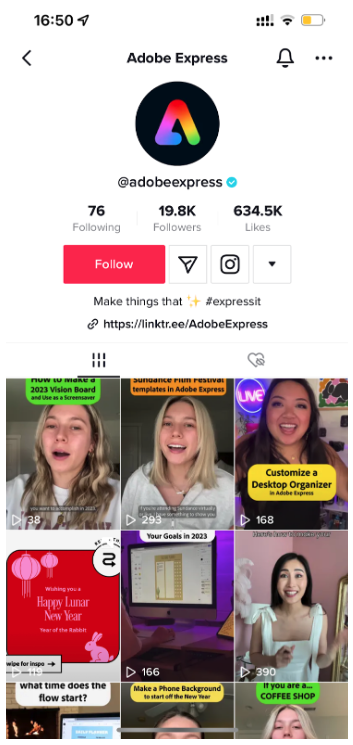
Takeaway:
So, what’s the big message for brands? It’s simple: Tailor your content for these platforms. Gen Z is looking for content that’s not just visually appealing but also engaging and useful. They’re a generation that’s constantly learning and discovering, and they want content that speaks their language.
This trend is a game-changer for how we define marketing strategies. With many Gen Zers spending significant time on social platforms, brands have a unique opportunity to engage with this demographic in a space they frequent. Unlike older generations, Gen Z workers and employees are growing up in an era where instant access to information is the norm, and they expect brands to keep up.
For businesses, especially new brands or those like Urban Outfitters that cater to younger consumers, this means rethinking traditional marketing approaches. Understanding how Gen Zers use these platforms can help brands solve problems creatively and connect with a generation that’s shaping future trends.
For brands aiming to resonate with younger millennials, Gen Z adults, or even the oldest members of this generation, adapting to their media consumption habits is key. It’s about meeting them where they are and providing content that enriches their day-to-day lives. Welcome to the new wave of search engines – it’s visual, it’s fast-paced, and it’s right where Gen Z loves to be.
5. User-Generated Content (UGC) At The Forefront
User-Generated Content (UGC) is not just a trend; it’s the essence of Gen Z’s interaction with the online world. Consider this: around 60% of TikTok’s users are Gen Zers, who are not just passive scrollers but active creators and sharers of content. The reason 61% lean more towards UGC than traditional marketing is simple – it feels authentic. Starbucks, for instance, has tapped into this goldmine by highlighting real customer experiences with their products on Instagram.
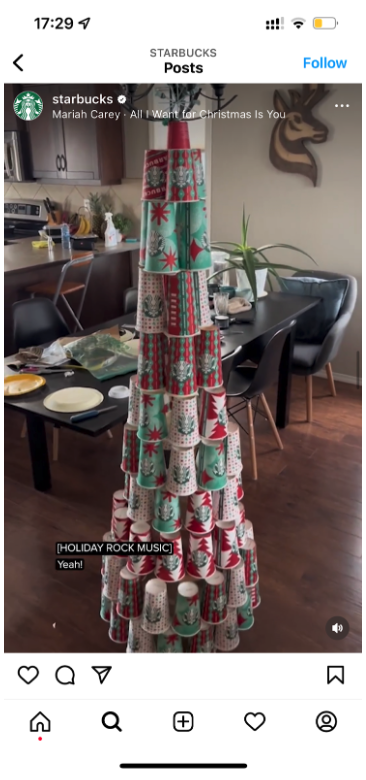
Starbucks regularly reposts reels from customers who’ve used or featured Starbucks products in their content. Christmas time, in particular, is full of customers posting content with Starbucks holiday-themed cups and seasonal drinks like toasted white chocolate mocha.
Takeaway:
So, what’s the strategy for brands? Motivate and inspire Gen Z to create and share content related to your brand. This approach is a game-changer. It doesn’t just build trust; it fosters a sense of community that is immensely valuable.
The rise of UGC marks a significant shift in how younger generations, particularly Gen Z adults and the millennial generation, engage with brands. Unlike previous generations, Gen Zers and even the oldest Gen Zers are more likely to trust a peer’s recommendation over a polished ad campaign. This trust is crucial for brands aiming to establish a genuine connection with this demographic.
Gen Z’s inclination towards UGC is also shaping how they spend their time and money. According to the Pew Research Center, this generation values authenticity and community, often using platforms like TikTok and Instagram to express themselves and discover new products and services.
In a world where remote work and online interactions are becoming the norm, UGC offers a way for young people, especially those who own businesses or are considering starting one, to engage with brands on a more personal level. This engagement is not just limited to making purchasing decisions; it’s about being part of a brand’s narrative.
For brands, the rise of UGC presents an opportunity to redefine marketing strategies. Encouraging Gen Z to create content is not just about generating buzz; it’s about building lasting relationships. As we move into a new era where digital content is king, UGC stands out as a genuine, trusted, and influential form of communication.
Fun, Creative Content
Think about how many trends we’ve seen on TikTok in the past year. Dance challenges, recipes, and lip-syncing battles seem to keep evolving and inspire users to create new content. 76% of all Gen Zers use TikTok, and 78% of Gen Zs use TikTok to find funny or entertaining content, and Gen Zers have high affinity for humor. Considering Gen Z is the most stressed demographic, it’s no wonder they seek lighthearted content.
Takeaway:
- Appeal to Gen Z’s humor and have fun with your content.
- Get creative and look for unique opportunities to engage your audience.
- Use trending audio and visual formats to create fresh content and increase your chances of going viral.
Create Marketing Campaigns That Click With Gen Z
With this generation set to be the biggest consumers of the future, it’s important to be aware of Gen Z trends to appeal to them. Understand what makes them tick and use the right content on the right platforms to reach them. Experiment with different types of content and marketing strategies to determine what resonates with your target audience.
Whatever you do, make sure you’re authentic and entertaining. Gen Zers have a penchant for funny, creative content that resonates with their experiences. Keep your content engaging, relevant, and true to your brand identity—this is the key to capturing Gen Z’s attention.
